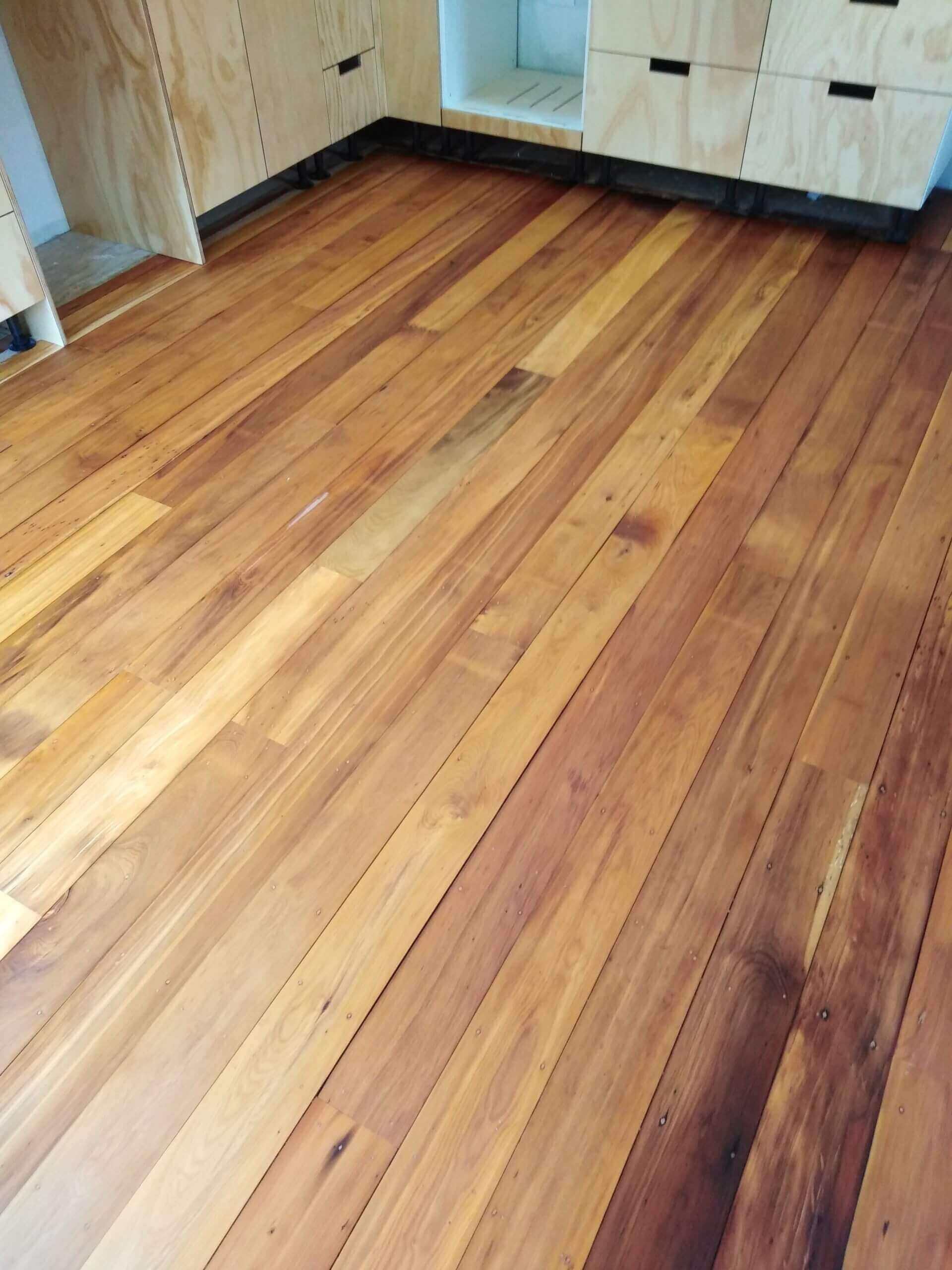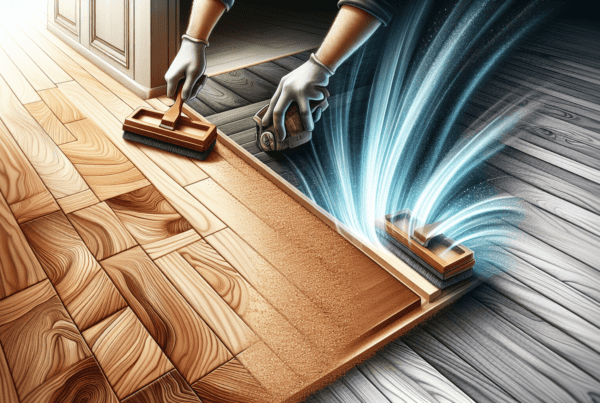If you’re in Wellington and looking for expert timber floor sanding and finishing services, look no further. At Four Star Flooring, our team of specialists are not only experts in their field but also have a true passion for what they do. With decades of combined experience in the industry, we offer a full range of flooring services to breathe new life into your floors. From timber floor sanding to polyurethane floor coatings, staining, and even unique whitewashed and blockout floor finishes, we have the knowledge and expertise to give you beautiful and hard-wearing floors. Trust us to customize your timber floor colors and provide you with a stunning finish that will impress all.
Expert Timber Floor Sanding and Finishing Services in Wellington
At Four Star Flooring, we are proud to offer expert timber floor sanding and finishing services in Wellington. Our team of timber flooring specialists has decades of combined experience in the industry and a true passion for what they do. Whether your timber floors are looking dull and worn out or you simply want to give them a fresh new look, our sanding and finishing services can help breathe new life into your floors.
Why Timber Floor Sanding is Important
Timber floor sanding is an essential process for maintaining the beauty and longevity of your timber floors. Over time, timber floors can become scratched, stained, and worn out due to everyday use and foot traffic. Sanding the floors helps to remove these imperfections and create a smooth and even surface. This not only improves the appearance of the floors but also prepares them for the application of finish coatings.
The Process of Timber Floor Sanding
The process of timber floor sanding involves the use of specialized equipment to strip away the top layer of the timber, revealing the fresh wood underneath. Our experienced technicians use professional sanding machines that are designed to effectively remove imperfections without causing damage to the timber. The process typically involves multiple passes with increasingly fine grit sandpaper to ensure a smooth and even finish.
Equipment Used for Timber Floor Sanding
Our team utilizes state-of-the-art sanding equipment for the best results. We use powerful and efficient sanding machines that are specifically designed for timber floors. These machines have adjustable settings for different types of timber and can effectively remove imperfections while preserving the integrity of the wood. In addition to the sanding machines, we also use dust extraction systems to minimize dust and debris during the sanding process.
Benefits of Professional Timber Floor Sanding
Opting for professional timber floor sanding services offers numerous benefits. Firstly, it helps to restore the natural beauty and shine of your timber floors, making them look like new again. The removal of scratches, stains, and imperfections can significantly enhance the overall appearance of your space. Additionally, sanding the floors creates a smooth and even surface, making it easier to clean and maintain them in the future. Lastly, professional sanding ensures that the job is done correctly and efficiently, saving you time and effort.
Polyurethane
What is Polyurethane Floor Coating?
Polyurethane floor coating is a popular choice for timber floors due to its durability and high-gloss finish. It is a type of protective coating that is applied to the surface of the timber floors after sanding and provides a hard-wearing and long-lasting finish. Polyurethane floor coatings are known for their resistance to scratches, stains, and general wear and tear, making them an excellent choice for high-traffic areas.
Types of Polyurethane Floor Coatings
There are different types of polyurethane floor coatings available, including oil-based and water-based options. Oil-based polyurethane coatings offer a warm and amber-toned finish and are known for their durability. They can take longer to dry, but they provide excellent protection for timber floors. On the other hand, water-based polyurethane coatings offer a clear and natural finish and have a faster drying time. They are also known for their low odor and environmental friendliness.
Application Process of Polyurethane Floor Coatings
Applying polyurethane floor coatings requires careful preparation and technique to ensure a smooth and flawless finish. After the timber floors have been sanded and cleaned, the polyurethane coating is applied using specialized tools such as applicators or brushes. The number of coats applied depends on the desired level of protection and finish. Each coat is allowed to dry completely before applying the next coat, and the process is typically repeated multiple times for optimal results.
Advantages and Disadvantages of Polyurethane Floor Coatings
Polyurethane floor coatings offer several advantages, including their high durability and resistance to scratches, stains, and wear and tear. They provide a beautiful and glossy finish that enhances the natural beauty of the timber. Additionally, polyurethane coatings are relatively easy to maintain and can last for many years with proper care. However, they can be more expensive compared to other types of floor finishes. Additionally, the application process can be time-consuming, and the strong fumes during the drying process may require proper ventilation.
Staining
The Importance of Timber Floor Staining
Timber floor staining is a popular choice for homeowners who want to customize the color of their timber floors. Staining can transform the look of your floors, adding depth, character, and warmth. It helps to highlight the natural grain and texture of the timber, creating a unique and personalized look for your space. Besides aesthetic benefits, staining also provides an extra layer of protection for the timber, helping to prevent damage from moisture and UV rays.
Different Types of Timber Floor Stains
There are various types of timber floor stains available, ranging from light tones to dark shades. Some popular options include traditional stains, which provide a rich and classic look, and more modern options such as whitewash stains, which create a light and airy feel. Additionally, there are specialized stains available for specific timber species, which can enhance the natural beauty and characteristics of the wood.
Applying Timber Floor Stains
Applying timber floor stains requires careful preparation and technique to achieve the desired color and finish. Before applying the stain, the timber floors need to be properly sanded and cleaned to ensure a smooth and even surface. The stain is applied using brushes, applicators, or spray bottles, depending on the desired effect. It is important to follow the manufacturer’s instructions and apply the stain evenly to avoid patchiness or streaks. After applying the stain, a protective coating such as polyurethane or oil is applied to seal and protect the stained timber.
Tips for Choosing Timber Floor Stain Colors
When choosing timber floor stain colors, it is important to consider the overall aesthetic of your space and your personal preferences. Lighter stain colors can create a more open and airy feel, while darker stains can add depth and richness to the floors. Additionally, consider the color and style of your furniture and decor to ensure a cohesive and harmonious look. It can be helpful to test different stain samples on a small area of the floor to see how they look with the lighting and other elements in your space.
Oil or Water-based Poly
Understanding Natural Oil and Water-based Polyurethane Finishes
Natural oil and water-based polyurethane finishes are two popular options for protecting and enhancing the beauty of timber floors. Natural oil finishes penetrate the timber, providing a rich and warm look while allowing the wood to breathe. Water-based polyurethane finishes, on the other hand, create a clear and durable surface coating that adds a glossy finish to the timber.
Comparison between Oil and Water-based Polyurethane Finishes
There are several factors to consider when choosing between oil and water-based polyurethane finishes for your timber floors. Oil finishes offer a more natural and traditional look, emphasizing the natural grain and texture of the timber. They are relatively easy to touch up or repair, and they tend to hide scratches and imperfections better than water-based finishes. On the other hand, water-based polyurethane finishes offer a faster drying time, low odor, and environmental friendliness. They provide excellent scratch resistance and durability.
Benefits of Using Natural Oil Finishes
Natural oil finishes offer several benefits for timber floors. They deeply penetrate the wood, enhancing its natural beauty and color. The oil helps to nourish and protect the timber, making it more resistant to moisture and wear. Additionally, oil finishes allow the wood to breathe, which can be beneficial in areas with fluctuating humidity levels. Another advantage of oil finishes is their ease of maintenance, as they can typically be spot-repaired or rejuvenated without needing to sand and refinish the entire floor.
Advantages of Water-based Polyurethane Finishes
Water-based polyurethane finishes have become increasingly popular due to their numerous advantages. They offer excellent clarity, creating a crystal-clear and glossy finish on the timber floors. Water-based finishes are known for their fast drying time, allowing for quick completion of the project. They also emit low odors compared to oil-based finishes, making them more suitable for indoor applications. Water-based polyurethane finishes provide exceptional durability and scratch resistance, ensuring that your timber floors remain beautiful and protected for years to come.
Whitewash & Blockout
Creating Unique and Stunning Floors with Whitewash
Whitewashing floors is a popular technique for achieving a unique and timeless look. It involves applying a diluted white paint or stain to the timber floors, allowing the natural grain and texture to show through. Whitewashed floors create a light and airy feel, making them perfect for spaces that need a touch of brightness and elegance. This technique is particularly popular for beach and Scandinavian-inspired interiors.
Blockout Floors: Adding Drama to Your Space
Blockout floors are a bold and dramatic choice for those who want to make a statement with their timber floors. This technique involves using dark wood stains to create a contrasting look, highlighting specific areas or patterns on the floors. Blockout floors add depth and interest to the space, creating a focal point and enhancing the overall aesthetic. This technique is commonly used in modern and contemporary interiors.
Process of Whitewashing Floors
Whitewashing floors involves several steps to achieve the desired effect. Firstly, the timber floors need to be properly sanded and cleaned to ensure a smooth and even surface. Then, a white paint or stain is mixed with water to create a diluted solution. This diluted mixture is applied to the floors using brushes, applicators, or sprayers, allowing the solution to penetrate the wood and create a light and washed-out look. After the whitewash has dried, a protective coating such as polyurethane or oil is applied to seal and protect the floors.
Pros and Cons of Blockout Floors
Blockout floors offer several advantages for those looking for a unique and dramatic look. They create a striking contrast between the dark stained areas and the rest of the timber, adding depth and visual interest to the space. Blockout floors can also help to hide imperfections or unevenness in the floors. However, it is important to note that blockout floors can be more challenging to maintain and touch up compared to traditional stained floors. Additionally, the dark stain may show scratches more easily, requiring regular maintenance and care.
Breathe New Life Into Your Floors with Timber Floor Sanding
Signs that Your Timber Floors Need Sanding
There are several signs that indicate your timber floors may need sanding. These include visible scratches, stains, or discoloration on the surface of the floors. If your floors feel rough or uneven to the touch, it may be time to consider sanding. Additionally, if your floors have lost their shine and appear dull or worn out, sanding can help to restore their natural beauty. It is recommended to have a professional assess the condition of your floors to determine if sanding is necessary.
Benefits of Sanding your Timber Floors
Sanding your timber floors offers numerous benefits. Firstly, it helps to eliminate scratches, stains, and imperfections, creating a smooth and even surface. This not only enhances the appearance of the floors but also makes them easier to clean and maintain. Sanding also helps to remove any build-up of old finishes or coatings, allowing for the application of new coatings for a fresh and updated look. Furthermore, sanding can help to prolong the lifespan of your timber floors by removing any damaged or weakened areas.
The Process of Sanding and Refinishing Timber Floors
The process of sanding and refinishing timber floors involves multiple steps to ensure a professional and long-lasting result. Firstly, the floors are thoroughly inspected and prepared, including removing any furniture or obstacles from the area. Then, the sanding process begins, starting with coarse grit sandpaper to remove the old finish and imperfections and progressing to finer grits for a smoother finish. After sanding, the floors are thoroughly cleaned and vacuumed to remove any dust or debris. Finally, the chosen finish, such as polyurethane or oil, is applied to the floors, providing protection and enhancing their appearance.
Polyurethane Floor Coatings… Beautiful Finish, Hard-wearing Floors
Advantages of Polyurethane Floor Coatings
Polyurethane floor coatings offer several advantages for timber floors. Firstly, they provide a beautiful and glossy finish, enhancing the natural beauty of the timber. Polyurethane coatings also offer excellent durability and resistance to scratches, stains, and wear and tear, making them ideal for high-traffic areas. Additionally, polyurethane coatings are relatively easy to clean and maintain, requiring minimal effort to keep your floors looking their best.
Best Applications for Polyurethane Floor Coatings
Polyurethane floor coatings are suitable for various applications, both residential and commercial. They are commonly used in living rooms, bedrooms, hallways, and other areas where the floors are exposed to regular foot traffic. Polyurethane coatings are also ideal for commercial spaces such as offices, retail stores, and restaurants, where durability and easy maintenance are essential. Additionally, they can be applied to both solid timber floors and engineered timber floors.
How to Care for Polyurethane Coated Floors
Caring for polyurethane coated floors is relatively simple. Regular maintenance includes sweeping or vacuuming the floors to remove any dust or debris and ensuring that spills are promptly cleaned up to prevent staining. It is important to avoid using harsh chemicals or abrasive cleaners on polyurethane coated floors, as these can cause damage. Instead, use a mild detergent or specially formulated cleaner that is safe for use on timber floors. Additionally, it is recommended to place felt pads or furniture glides under furniture legs to prevent scratches and dents.
Floor Staining – Customizing Your Timber Floor Colours
Benefits of Timber Floor Staining
Timber floor staining offers several benefits for homeowners who want to customize the color of their floors. Firstly, staining allows you to achieve a unique and personalized look that reflects your style and preferences. Whether you prefer a warm and rich tone or a light and airy feel, timber floor staining can help you achieve the desired effect. Staining also helps to enhance the natural beauty of the timber, highlighting the grain and texture for a more visually appealing floor. Additionally, staining provides an extra layer of protection for the timber, helping to prevent damage from moisture and UV rays.
Different Staining Techniques and Effects
There are various staining techniques and effects that can be achieved depending on the desired look. Traditional staining involves applying a single color stain to the timber, creating a uniform and consistent appearance. This technique is perfect for those looking for a classic and timeless look. On the other hand, multiple stain colors can be combined to create a more unique and artistic effect, such as a blend of light and dark tones or a gradient effect. Additionally, different application methods, such as wipe-on or spray techniques, can also create different effects.
Factors to Consider When Choosing Stain Colors
When choosing stain colors for your timber floors, several factors should be considered. Firstly, consider the overall aesthetic of your space and the desired mood or atmosphere. Lighter stain colors can create a more open and airy feel, while darker stains add depth and richness. Additionally, consider the color and style of your furniture and decor to ensure a cohesive and harmonious look. It can be helpful to test different stain samples on a small area of the floor to see how they look with the lighting and other elements in your space.
Maintaining Stained Timber Floors
Maintaining stained timber floors is relatively easy with regular care and maintenance. Sweep or vacuum the floors regularly to remove dust and debris, as these can cause scratches over time. Avoid using abrasive cleaners or harsh chemicals that can damage the stain or the protective coating. Instead, use a mild detergent or specially formulated cleaner that is safe for use on timber floors. It is also recommended to place doormats at entryways to prevent dirt and grit from scratching the floors and to promptly clean up any spills to prevent staining.
Whitewashed Floors & Blockout Floors – Unique & Stunning
The Aesthetic Appeal of Whitewash and Blockout Floors
Whitewashed floors and blockout floors offer a unique and stunning aesthetic appeal. Whitewashed floors create a light and airy feel, making them perfect for spaces that need a touch of brightness and elegance. This technique enhances the natural grain and texture of the timber, creating a visually appealing and unique look. On the other hand, blockout floors add drama and depth to a space with their contrasting dark stained areas. Blockout floors are a bold choice for those looking to make a statement and create a focal point in their interior.
Preparing the Floors for Whitewashing
To prepare the floors for whitewashing, it is important to properly sand and clean the surface to ensure a smooth and even finish. Sanding removes any imperfections, scratches, or old finishes that may hinder the adhesion of the whitewash. Once the floors have been sanded, they should be thoroughly cleaned and vacuumed to remove any dust or debris. It is essential to start with clean and dry floors to achieve the desired whitewash effect.
Creating Blockout Floors with Wood Stains
Creating blockout floors involves the application of dark wood stains to specific areas or patterns on the timber floors. This technique can be used to highlight architectural features, create visual interest, or simply add a dramatic touch to a space. To create blockout floors, the timber floors need to be properly sanded and cleaned to ensure a smooth and even surface. The chosen wood stain is then applied to the desired areas using brushes, applicators, or spray bottles. It is important to apply the stain evenly and remove any excess to achieve the desired effect.







